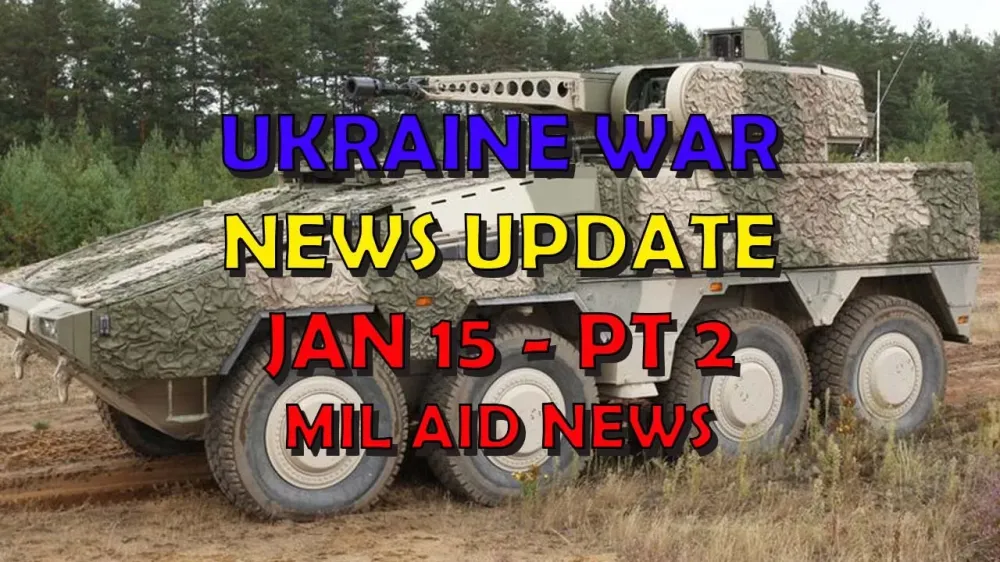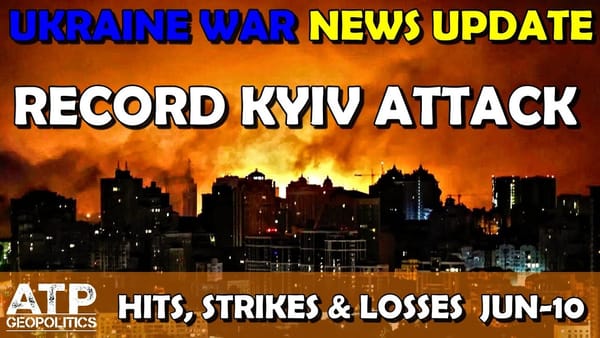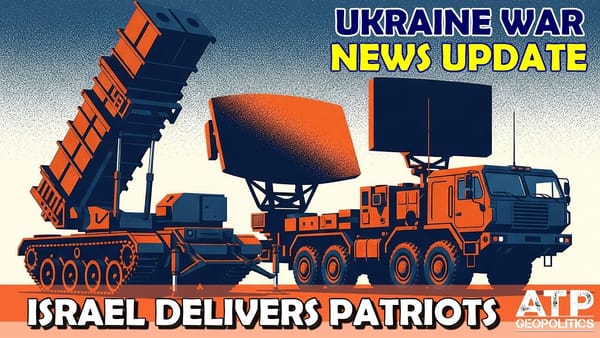Ukraine War Update NEWS: Military Aid News - RCT30, German Aid, Mertletts
Table of Contents 📖
"It's not just about shooting guns anymore. It's about data fusion interfaces in high-intensity warfare."
Hello Team
🎦 00:00-00:14⏩
Jonathan welcomes viewers to another ATP Geopolitics video, a Ukraine War News Update for 11 January 2025. This is the second part of the update, focusing on Military Aid news.
Return to top⤴️
Upcoming Ramstein Meeting and German Defence Minister's Visit to Kyiv
🎦 00:14-01:08⏩
Jonathan reports that the next Ramstein meeting is scheduled for February 14-16, a week before the Munich Security Conference. He adds that German Defence Minister Boris Pistorius made an unannounced visit to Kyiv to demonstrate Germany’s ongoing support for Ukraine.
Return to top⤴️
Germany's Military Aid to Ukraine
🎦 01:08-02:54⏩
Pistorius affirmed that Germany's support for Ukraine will remain steadfast, irrespective of the upcoming Bundestag election results. Jonathan notes that Pistorius is a popular figure who would make a strong leader for the SDP, but he is not running, leaving Olaf Scholz as the likely candidate. Jonathan predicts the election will result in a coalition, possibly involving the incumbent party (SDP), the Greens, and the FDP, or a grand coalition with the CDU. He believes a coalition with the AFD is unlikely. Germany has also prepared an additional 3 billion euros in aid for Ukraine, although the financing details are still being finalised. Zelensky has stated that Germany's aid contributions make up about 16% of the total aid received by Ukraine to date, a substantial portion considering the involvement of over two dozen countries. Jonathan commends Germany for its significant contributions to Ukraine, both in terms of pledges and actual deliveries. He acknowledges that while there have been delays, Germany has done a commendable job. He highlights German editor Ukraine's website (DEAIDUA.org) as an excellent resource for tracking German military aid to Ukraine. The website lists deliveries, pledges and future deliveries.
Return to top⤴️
Germany: Delivery of Boxer RCT30s and RCH-155 Howitzers
🎦 02:54-08:17⏩
Jonathan discusses the recent delivery of nine Boxer RCT30s to Ukraine, specifically designed as command and control vehicles for RCH-155 howitzers. He explains that these RCT30s are not infantry fighting vehicles, but rather act as fire control centres for batteries of six RCH-155s. Jonathan points out that Germany has pledged a total of 54 RCH-155s, with each battery consisting of six howitzers and one RCT30. These howitzers are expected to be fully remote-controlled in the future, offering significant tactical advantages. He references a tweet by Julian Röpcke, a journalist for Bild, highlighting how a September 2022 announcement about Ukraine’s direct purchase of 18 RCH-155s from the manufacturer, KMW, with deliveries starting in March 2025, is now coming to fruition. This demonstrates the long-term planning involved in military aid. Jonathan recalls that at the time, there was a sense of urgency, with many believing Ukraine needed immediate support, not deliveries in 2025. He recounts receiving criticism from an individual named Patricia Marins for highlighting the delayed delivery timeline, but notes these howitzers are now being delivered, highlighting the importance of such long-term commitments.
Return to top⤴️
Germany: Leopard 1A5 Tanks and Solar Modules for Kherson
🎦 08:17-13:16⏩
Jonathan discusses a report from German-Ace Ukraine that the 425th Assault Regiment has received Leopard 1A5 main battle tanks, jointly donated by Germany, Denmark, and the Netherlands. The tanks are equipped with additional reactive armour, drone nets, and camouflage. He notes the Leopard 1A5, while an older model, is still a capable tank that has been upgraded. Ukrainian soldiers have praised the tanks for their speed, maneuverability, and accuracy. Jonathan then shifts to the news that the German state of Schleswig-Holstein will provide €500,000 for solar modules to be used in Kherson. He applauds this initiative, emphasizing the importance of decentralising Ukraine's energy infrastructure for increased resilience. By shifting away from reliance on large, vulnerable power plants to localised power generation, such as solar, Ukraine can mitigate the impact of Russian strikes on its energy grid. Jonathan points out that while solar power may not be as efficient in winter, a diversified energy mix with local production is crucial for Ukraine. He commends the decision, seeing it as a step towards greater energy security and independence for Ukraine. He believes that this approach will force Russia to target numerous smaller energy points, making it more challenging to cripple Ukraine’s energy grid. Jonathan highlights that the first 300 solar modules have already been delivered to Kherson, with another 200 scheduled by the end of February. He expresses hope that these modules will be deployed on critical infrastructure to ensure a continuous power supply, especially as Ukraine announces scheduled power outages. He concludes by saying that having these independent energy sources will be incredibly beneficial.
Return to top⤴️
UK: Military Aid Pledges and Economic Situation
🎦 13:16-14:46⏩
Jonathan discusses the UK’s pledge to continue supporting Ukraine’s defence industry, including funding for air defence systems and long-range weapons production. This pledge comes amid a challenging economic climate for the UK. He points out that while the UK is facing economic difficulties with a large budget deficit and inflation, albeit lower than previously predicted, the commitment to Ukraine remains strong. Jonathan says it’s a big deal for the UK to continue announcing these support packages given their economic issues. He adds that Ukrainian Defence Minister Rustem Umarov, during his visit to the UK, stated that the UK's investment in Ukraine's weapons production is ongoing. Jonathan cites Maxar reporting that during Umarov’s meeting with UK Defence Secretary John Healey, particular attention was paid to strengthening Ukraine's defence industrial complex. He sees this as a positive development, indicating a move towards a more sustainable model of support for Ukraine's defence capabilities, akin to the Danish model.
Return to top⤴️
UK: Martlet Lightweight Multi-Role Missile Production
🎦 14:46-16:03⏩
Jonathan reports that the UK will increase Martlet lightweight multi-role missile production and deliver 650 missiles to Ukraine. He details that the UK has committed £162 million to boost LMM production and supply these advanced missile systems. Jonathan reminds viewers that during his previous video summarising the Ukraine Defence Contact Group (UDCG) meeting and US activities, the Pentagon statement mentioned scaling up LMM production as part of the UDCG efforts.
Return to top⤴️
Martlet LMM Capabilities and Ukrainian Ratel S UGVs
🎦 16:03-17:01⏩
Jonathan describes the Martlet LMM as a lightweight, adaptable missile equipped with laser and infrared guidance, ideal for precision strikes against drones, helicopters, and low-flying aircraft. He adds that it can be used in various configurations, including man-portable systems with tripods, vehicle-mounted systems, and on helicopters, similar to Stinger missiles. He shares his excitement over images of numerous Ukrainian Ratel S unmanned ground vehicles (UGVs) prepared for frontline service. Jonathan recalls a recent live stream discussion with Operator Starsky, Jonathan Fink, and himself, where they discussed how 2025 will be the year of the unmanned ground vehicle. Jonathan believes this prediction is accurate, as evidenced by the increasing use of UGVs, citing a recent example of the Khartia regiment conducting a fully robotic attack, supported by shaping operations. He speculates that the Ratel S UGVs appear to have a modular design, allowing for various attachments such as turrets, mine layers, and other equipment. He sees the deployment of these UGVs as a positive development for Ukraine. Jonathan acknowledges that Russia has been quicker to deploy UGVs on the battlefield, but the increasing use by Ukraine signifies a shift in the conflict.
Return to top⤴️
Ukraine's Need for F-16s and Potential Russian Offensive
🎦 17:01-18:32⏩
Jonathan discusses a statement by Ukrainian military expert Vladislav Selesnyov, who asserts that Ukraine needs 130 F-16s to effectively counter Russian advancements. He suggests that Russia might halt operations at the Donetsk Oblast border and launch an offensive towards Dnipropetrovsk. Jonathan believes Ukraine currently has fewer than 100 F-16s, and even if they receive all promised aircraft (estimated to be around 85), they would still need a significant number to reach the required 130. He notes that Ukraine is also expecting an unknown number of Mirage jets, with estimates around 12. He adds that with France potentially phasing out Mirages and increasing production of Rafales, Ukraine might receive the remaining Mirage inventory. There are also rumours about potential Gripen deliveries. Jonathan concludes that Ukraine undeniably needs more planes, pilots, and maintenance crews, which has led to the reassignment of maintenance crews to infantry units. He expresses concern over the lack of clarity regarding the number of operational aircraft Ukraine has at its disposal.
Return to top⤴️
Peacekeeping Forces and French Special Forces Exercise
🎦 18:32-21:14⏩
Jonathan reports that Zelensky discussed the deployment of foreign peacekeeping forces in Ukraine with Macron two days before the video. He then shifts focus to a report indicating that French special forces conducted a highly secretive exercise in late 2024, preparing for a potential intervention in Ukraine. This follows comments by French President Emmanuel Macron and UK Prime Minister Keir Starmer about the possibility of European ground forces in Ukraine. The exercise, named “Perse”, simulated countering a Russian offensive from Belarus, drawing on lessons learned from Ukraine's successful containment of the initial invasion in 2022. Jonathan details the exercise involved France’s elite special forces unit, the Commandement des Actions Spéciales (CAST), comprising 3,200 soldiers. The training was designed to test personnel and equipment in a hostile river setting, similar to the Dnipro River bend north of Kyiv. They focused on deploying operators, drones, jamming techniques, interception capabilities, and data fusion interfaces for high-intensity warfare. Jonathan is impressed with the exercise’s sophistication, noting that modern warfare extends beyond traditional combat and encompasses advanced technologies and data analysis. He commends France for proactively preparing for potential future scenarios and for taking the possibility of further Russian aggression seriously.
Return to top⤴️
NATO Troop Deployment Discussions and Lithuania's Stance
🎦 21:14-22:26⏩
A European defence official revealed to CNN that there have been ongoing discussions within NATO about potentially deploying troops to a demilitarized zone in Ukraine, should it be part of a peace deal and if requested. Jonathan sees this as expected, highlighting that Putin's actions have tested the West's resolve. He references a CNN article that questions whether Trump will force the West to abandon Ukraine and notes that the US, particularly under Trump, is hesitant about sending troops to Ukraine. He believes that any NATO involvement in such a scenario would likely exclude US ground troops. Lithuania, however, hasn't dismissed the possibility of deploying troops to Ukraine if requested. Lithuanian Foreign Minister Gabrielius Landsbergis stated that Vilnius would consider such an appeal and discuss it with allies. Jonathan acknowledges that such a move would necessitate support from other nations. He reflects on Poland’s recent statement expressing reluctance due to its proximity to Ukraine, suggesting a preference for countries like Germany, France, the UK, Baltic states, and Nordic countries to take the lead. However, he doubts Germany and Poland’s willingness to commit troops.
Return to top⤴️
EU Aid to Ukraine and Moldova
🎦 22:26-22:48⏩
Jonathan briefly mentions that the EU has allocated an additional €150 million in humanitarian aid to Ukraine and Moldova.
Return to top⤴️
Russian FPV Technology Advancements
🎦 22:48-24:24⏩
Jonathan shifts focus to Russian military developments, highlighting images of a new Chinese machine capable of rewinding 10 kilometres of fibre optic cable onto a Russian-printed spool in just 100 minutes. This cable is intended for use in Russian FPV (first-person view) drones. He notes that each 10-kilometre spool weighs 1.35 kilograms, making it easily transportable. He points out that even a 20-kilometre spool, weighing 2.7 kilograms, would leave ample payload capacity on an octocopter drone like a Baba Yaga, enabling it to carry a substantial amount of munitions. Jonathan views this as a serious threat, as it allows FPV drones to operate at a 20-kilometre range with reduced vulnerability to electronic warfare interference. He emphasises the significant threat posed by these drones when deployed at scale. He highlights a report from November 2024 stating that Russia has been rapidly expanding its production of fibre optic cable-controlled FPV drones while also importing commercial spools from China. Jonathan concludes that this development is a considerable cause for concern for Ukraine, especially if Russia successfully produces these drones on a large scale and at a lower cost.
Return to top⤴️
Wrap up
🎦 24:24-24:32⏩
Jonathan thanks viewers for watching and expresses hope that the information shared was valuable and engaging. He signs off, promising to speak again soon.
Return to top⤴️



